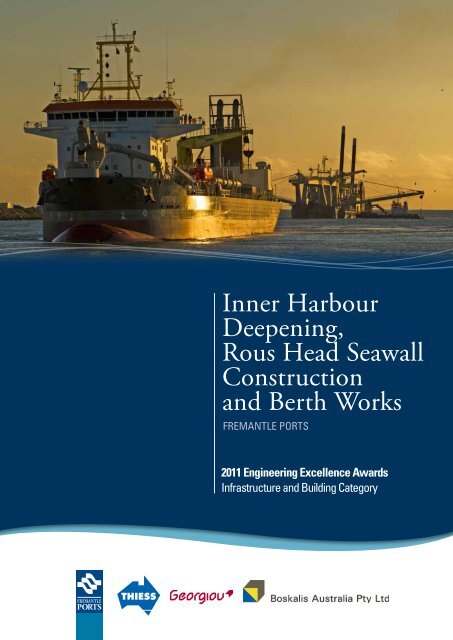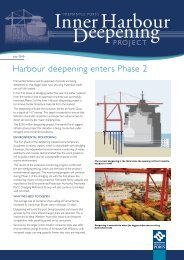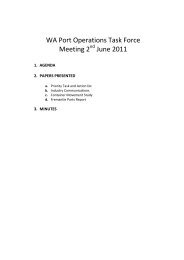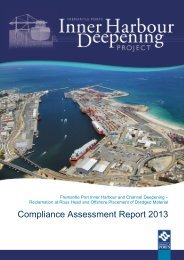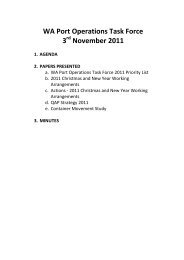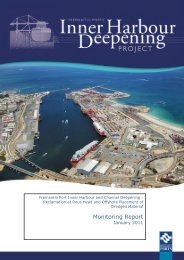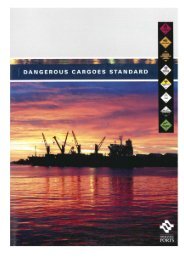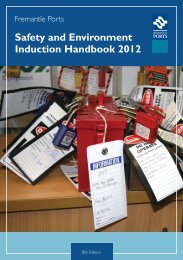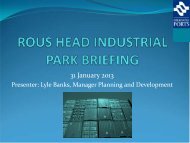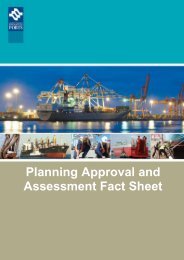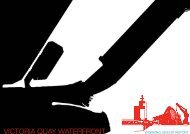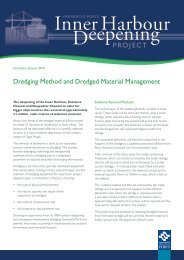IHD Engineering Awards submission - Fremantle Ports
IHD Engineering Awards submission - Fremantle Ports
IHD Engineering Awards submission - Fremantle Ports
Create successful ePaper yourself
Turn your PDF publications into a flip-book with our unique Google optimized e-Paper software.
Inner Harbour<br />
Deepening,<br />
Rous Head Seawall<br />
Construction<br />
and Berth Works<br />
FREMANTLE PORTS<br />
2011 <strong>Engineering</strong> Excellence <strong>Awards</strong><br />
Infrastructure and Building Category
Contents<br />
Executive Summary 3<br />
Categoration Statement 4<br />
Mandatory Judging Criteria 5<br />
Criteria 1: Attention to occupational health and safety 5<br />
Criteria 3: Originality and ingenuity of the solution 10<br />
Criteria 4: Actual or potential contribution of the work to the economy 13<br />
Criteria 5: Benefits to the community 15<br />
Criteria 6: Contribution to sustainable development 16<br />
Criteria 7: Significance of the work as a benchmark of Australian engineering 18<br />
Optional Judging Criteria 20<br />
Criteria 11:<br />
Cooperation with other disciplines and professions and/or effective use of community,<br />
government or industry consultation 20<br />
Criteria 15: Attention given to the needs of users 21<br />
Criteria 16: Enviroinmental Implications 23<br />
Criteria 17: Quality and Extent of Research 25<br />
Criteria 19: Integration and innovative use of computer modelling systems 26<br />
Attachments 27<br />
• Essential Information 27<br />
• Project Charter 28<br />
• Project Objectives 29<br />
• Dredging Reference Group Chairman’s Report 30
FREMANTLE PORTS<br />
Executive Summary<br />
The <strong>Fremantle</strong> <strong>Ports</strong> Inner Harbour Deepening and Berth<br />
Works project was completed in April 2011. The $250<br />
million infrastructure project was achieved on budget and<br />
within two years of the works commencing. It was one<br />
of the biggest projects undertaken at the port since the<br />
opening of <strong>Fremantle</strong> Harbour in 1897 and was essential to<br />
enable the port to remain competitive.<br />
The project involved constructing a sea wall at Rous Head<br />
to establish a reclamation area; dredging the Inner Harbour,<br />
entrance channel and deep water channel; reconstructing<br />
Berth 10 and strengthening berths 4 to 9 on North Quay.<br />
Constructed under the gaze and scrutiny of so many eyes,<br />
the Inner Harbour Deepening and Berth Works project will<br />
ensure <strong>Fremantle</strong> Port remains an efficient, modern working<br />
port able to handle current and future vessel requirements<br />
and trade needs.<br />
Studies by transport economic specialists showed that<br />
failure to deepen <strong>Fremantle</strong> Harbour in line with other<br />
Australian capital city ports would have led to a loss of<br />
major direct shipping services, with larger ships bypassing<br />
<strong>Fremantle</strong> and travelling to the eastern seaboard.<br />
The infrastructure works have contributed significantly<br />
to the long-term sustainability of <strong>Fremantle</strong> Port’s Inner<br />
Harbour as a major gateway for national and international<br />
trade and will ensure that Western Australian business<br />
continues to have access to major direct shipping services.<br />
Following the deepening of the harbour and upgrading<br />
of the existing container berths at North Quay, the port<br />
is able to provide access for container ships which were<br />
previously unable to load to full capacity. The reconstruction<br />
of Berth 10, previously unsuitable for container shipping,<br />
also provides an additional 180 metres of operational wharf<br />
space for the port’s container trade.<br />
Enabling the larger, more modern cargo ships to service the<br />
port also has benefits in terms of improved efficiency in fuel<br />
consumption and reduced greenhouse gas emissions.<br />
2011 <strong>Engineering</strong> Excellence <strong>Awards</strong> l Infrastructure and Building Category l Page 3
Categorisation Statement<br />
Post - Panamax ship MSC Confidence on first visit to <strong>Fremantle</strong><br />
<strong>Fremantle</strong> <strong>Ports</strong> embarked on its largest infrastructure<br />
project for decades with the deepening of the Inner Harbour<br />
and strengthening of North Quay wharves to cater for<br />
bigger container ships. The total infrastructure investment<br />
of $250 million included dredging and reclamation, a new<br />
seawall and berth upgrades at North Quay.<br />
The trend towards bigger ships has impacted ports<br />
worldwide with many deepening to overcome draft<br />
constraints. The average size of container ships calling at<br />
<strong>Fremantle</strong> Port has increased by about 85 per cent over the<br />
last 15 years and deepening was essential to enable the<br />
port to accommodate bigger ships at full cargo-carrying<br />
capacity.<br />
This major piece of maritime infrastructure is just the third<br />
harbour deepening project since <strong>Fremantle</strong> Harbour was<br />
created in 1897 by C Y O’Connor. His early meticulous<br />
planning has enabled the harbour to expand and evolve in<br />
response to changing demands, as evidenced by over 100<br />
years of continued use of <strong>Fremantle</strong> Harbour by shipping.<br />
Completion of the project means <strong>Fremantle</strong> will remain<br />
an efficient, modern working port able to handle vessel<br />
requirements and trade needs for the foreseeable future<br />
and builds on the legacy left by C Y O’Connor.
FREMANTLE PORTS<br />
Mandatory Judging Criteria<br />
Criteria 1:<br />
Attention to occupational health and safety<br />
Management<br />
The Inner Harbour Deepening and Berth Works project took<br />
place on the doorstep of more than 1.5 million residents<br />
and bordered metropolitan beaches and the Swan River.<br />
Due to the proximity of the works to popular recreational<br />
areas (including swimming beaches, fishing spots and<br />
boating areas) a key project objective was to ensure the<br />
safety not only of employees but also port users and the<br />
community.<br />
To ensure public safety, several access restrictions were<br />
established at various stages throughout the project.<br />
These included:<br />
• signs and notices to direct fisherman to alternative<br />
recreational fishing locations at North Mole<br />
• maritime exclusion zones were advised through<br />
Notices to Mariners<br />
• cessation of dredging and targeted monitoring prior<br />
to the Rottnest Channel Swim event to ensure safety<br />
of competitors<br />
• marker buoys on dredger anchor ropes.<br />
Extensive testing of the material to be dredged was<br />
undertaken before commencing the dredging to ensure<br />
its content posed no risk to human health or the marine<br />
environment. This work demonstrated that although there<br />
may be short-lived visible sediment plumes under certain<br />
wind and tide conditions, waters would be safe<br />
for swimmers.<br />
Design<br />
The project was a brown-field site with ongoing port<br />
operations a priority and <strong>Fremantle</strong> <strong>Ports</strong> had a very<br />
tight program to achieve, with multiple stakeholder and<br />
community issues to manage.<br />
Contractors, design engineers and operators participated<br />
in a series of workshops early in the design phase to<br />
identify, and where possible, eliminate interfaces between<br />
contractors and port operations.<br />
Key outcomes were:<br />
• agreements to excise the wharf from the port<br />
operating area<br />
• avoiding the use of floating plant for large scale<br />
demolition and construction activities<br />
2011 <strong>Engineering</strong> Excellence <strong>Awards</strong> l Infrastructure and Building Category l Page 5
FREMANTLE PORTS<br />
• eliminating the need for floating pipelines in the harbour<br />
during dredging operations<br />
• identifying piling noise levels and safe working<br />
envelopes and clearances for adjacent port operations<br />
through a trial piling program.<br />
During the Berth 10 design phase it was identified that<br />
maximising the degree to which works that could be carried<br />
out on top of the deck would enhance safety for workers<br />
and minimise interfaces with port operations. Using<br />
precast components rather than a fully in situ concrete deck<br />
improved safety with manufacturing done at ground level<br />
away from the water in a controlled environment. It also<br />
minimised the on-site workload and made available working<br />
space less confined.<br />
Special design attention was also given to safety of<br />
lifting equipment.<br />
Navigational safety and avoidance of ship collisions was<br />
also identified early as a key risk. To mitigate this <strong>Fremantle</strong><br />
Pilots and dredge masters undertook joint ship simulation<br />
exercises.<br />
Construction<br />
Safety was our number one priority and all participants,<br />
spent many hours working out safe ways of conducting the<br />
works both in Critical Risk Assessment Workshops<br />
and preparing Safe Working Method Statements.<br />
Multi-layered safety compliance was also required due to<br />
works being undertaken in the working port. The contractors<br />
undertook three safety inductions including their own safety<br />
system as well as <strong>Fremantle</strong> <strong>Ports</strong>’ and the stevedores’<br />
systems.<br />
Boskalis and TGJV prepared Safety, Environmental, Incident<br />
Response and Crisis Management Plans for the project,<br />
aligning with <strong>Fremantle</strong> <strong>Ports</strong>’ and the stevedores’ plans.<br />
Specific emergency plans were also developed for incidents<br />
on or under the berth and in the water, with joint incident<br />
response drills conducted.<br />
Critical Risk Assessment Workshops were conducted to<br />
cover the major phases of work.<br />
‘Safety Days of Action’ events were held regularly.<br />
The most difficult safety aspect to overcome on the berth<br />
works was the concept of working at heights and over<br />
water when approaching the construction areas from the<br />
ground level at the rear of the wharf. A detailed cutting<br />
pattern maximised remnant deck space while still allowing<br />
for piling and other works to progress.<br />
Handrails were installed around open areas and custombuilt<br />
frames, mesh grids and other structural components<br />
provided compliant and safe working platforms over water.<br />
Dredging was undertaken mainly during summer and spring<br />
to ensure this component of the works proceeded safely for<br />
marine-based crew and as quickly as possible.<br />
2011 <strong>Engineering</strong> Excellence <strong>Awards</strong> l Infrastructure and Building Category l Page 7
Safety of diving teams and the marine monitoring field<br />
team was of high importance, with strict safety protocols<br />
followed.<br />
Maximising remnant space enhanced worker safety by<br />
minimising higher risk work under the wharf deck and<br />
eliminated the need to use marine plant for piling and lifting<br />
works, thus avoiding adverse impact on port operations.
FREMANTLE PORTS<br />
2011 <strong>Engineering</strong> Excellence <strong>Awards</strong> l Infrastructure and Building Category l Page 9
Mandatory Judging Criteria<br />
Criteria 3:<br />
Originality and ingenuity of the solution<br />
<strong>Fremantle</strong> <strong>Ports</strong> opted to use an Early Contractor<br />
Involvement approach to plan the project before reverting to<br />
a series of lump sum contracts during the execution phase.<br />
The ECI phase involved preparing for the operation with<br />
three teams – <strong>Fremantle</strong> <strong>Ports</strong>, Thiess Georgiou JV and<br />
Boskalis Australia – over a six month period.<br />
Project Objectives and a Project Charter were jointly<br />
developed. The Charter was written into the preamble<br />
to the construction contracts to promote values of trust,<br />
respect and honesty.<br />
A Project Leadership Team (PLT) established during the ECI<br />
continued into the project delivery phase and monitored all<br />
project KPIs, working collaboratively to resolve any issues<br />
referred by the project management team.<br />
Throughout the project, continual improvement and<br />
professional development was facilitated through<br />
workshops and surveys.<br />
Another innovative practice adopted during the execution<br />
phase of the project was the undertaking of “Wellbeing<br />
Surveys” involving site and head office personnel to help<br />
identify early any potential problems in relationships and<br />
performance.<br />
Innovativeness of design, process<br />
or application<br />
<strong>Fremantle</strong> <strong>Ports</strong> manages its shipping operations with the<br />
aid of Dynamic Under Keel Clearance (DUKC©) 1 technology.<br />
to calculate the window of opportunity for ships to transit<br />
and exchange cargo in the port. In the planning phase,<br />
DUKC Technology was used to optimise channel design and<br />
minimise dredge depths.<br />
A series of real-time ship simulations was also undertaken<br />
to confirm navigational aspects of the design. These were<br />
performed in conjunction with <strong>Fremantle</strong> Pilots’ pilots using<br />
a full bridge simulator located in the port.<br />
The combined use of DUKC technology and ship simulations<br />
reduced the volume of dredging needed and provided the<br />
Harbour Master and marine pilots with confidence that<br />
the channel design and dredge depths could be safely<br />
navigated for larger ships.<br />
To cater for the heavier loads bigger ships impose on wharf<br />
infrastructure, the North Quay container berths required<br />
strengthening, and in the case of Berth 10, demolition and<br />
complete reconstruction.<br />
Although a relatively simple structure, the Berth 10<br />
reconstruction was complex due to the constrained site,<br />
access issues, working over or near water and coordinating<br />
multiple activities such as piling, concrete cutting and<br />
removal, precast installation and in situ concreting.<br />
The new berth design was tailored to avoid clashes with<br />
existing pile grids from remnant structures and the design<br />
was carried out maximising deck planks and thinning down<br />
1<br />
<strong>Fremantle</strong> <strong>Ports</strong> DUKC system is developed and operated by OMC International Pty Ltd
FREMANTLE PORTS<br />
the mid-sections to save on materials and weight.<br />
TGJV developed a precise cutting sequence for the<br />
demolition to maximise space on the existing structure<br />
being used for constructing the new deck.<br />
A specially designed crucifix support frame provided<br />
temporary support for the precast beams.<br />
A new sheet pile wall was also installed to hold back the<br />
slopes under the wharf. The installation along the face<br />
of the berth used a custom-built guide attached to the<br />
front of the berth.<br />
Before installation of the new sheet pile wall in the paleo<br />
channel (ancient flow path of the Swan River), an existing<br />
shorter sheet pile wall had to be removed. It was not<br />
possible to remove this without supporting the toe of the<br />
batter slope and after investigation of various options,<br />
the solution adopted was to place railway ballast along<br />
the face of the existing sheet pile wall. The rail ballast<br />
was then airlifted along the wall in advance of sheet pile<br />
removal and installation works, or placed behind the new<br />
sheet pile wall to improve slope stability.<br />
Achievement of outcomes<br />
Despite the many unknowns in terms of costs and risks,<br />
the Inner Harbour Deepening and Berth Works project<br />
achieved all of its objectives and has provided improved<br />
infrastructure in the time frame required and on budget.<br />
This outcome can largely be contributed to the use of<br />
Early Contractor Involvement in the planning phase and<br />
the continued effort in promoting the Project Charter. This<br />
approach was unique in that, despite the execution phase<br />
being lump sum contracts, relationship principles endured<br />
from the ECI phase.<br />
2011 <strong>Engineering</strong> Excellence <strong>Awards</strong> l Infrastructure and Building Category l Page 11
Also unique to the project was the running of two ECI<br />
contracts concurrently. Despite there being no contractual<br />
arrangement between Thiess Georgiou JV and Boskalis<br />
Australia during the ECI period, both organisations worked<br />
together in one office, with <strong>Fremantle</strong> <strong>Ports</strong>, examining the<br />
project risks together, developing solutions and building<br />
relationships.<br />
Potential for future applications<br />
This project was the first to be undertaken by <strong>Fremantle</strong><br />
<strong>Ports</strong> as a relationship-based project and its success leads<br />
the way to further projects being undertaken in a similar<br />
way not only by <strong>Fremantle</strong> <strong>Ports</strong>, but also by other<br />
WA ports.<br />
Further details of the innovation, originality and ingenuity<br />
of the project team’s approach to issues and problem<br />
solving are provided in the following sections.<br />
• Criteria 17: Quality and extent of research.<br />
• Criteria 19: Integration and innovative use of<br />
computer modelling systems.
FREMANTLE PORTS<br />
Mandatory Judging Criteria<br />
Criteria 4:<br />
Actual or potential contribution of the work to the economy<br />
Efficiency in use of resources<br />
The Port of <strong>Fremantle</strong> is Western Australia’s principal<br />
national and international gateway for container and<br />
general cargo trades, handling about 71 per cent by value<br />
of the State’s seaborne imports and 15 per cent by value of<br />
WA’s seaborne exports. It is of immense value to the State’s<br />
economy and its existing infrastructure represents a huge<br />
public and private sector investment as the port has been<br />
developed, modernised and expanded over the years.<br />
The deepening of the Inner Harbour and berth strengthening<br />
helps to ensure that the Inner Harbour is able to reach<br />
optimal capacity, thus efficiently using its resources in the<br />
State’s interest.<br />
Maximising use of infrastructure has benefits in terms of<br />
minimising freight costs. The additional quay length for<br />
container shipping gained by the re-building of Berth 10 and<br />
the additional land created as a by-product of the dredging<br />
also helps to push out the number of years before the Inner<br />
Harbour reaches capacity and additional facilities need to<br />
be built to service trade growth.<br />
<strong>Fremantle</strong> Port’s deeper draft capacity and ability to service<br />
the larger, more efficient ships fully loaded means the same<br />
volumes of cargo can be carried on fewer ship visits, with<br />
benefits in terms of economies of scale, fuel savings and<br />
reduced greenhouse gas emissions.<br />
Efficiency in the application of<br />
engineering resources<br />
The use of the Early Contractor Involvement model in<br />
the project planning and the effective partnership that<br />
ensued between <strong>Fremantle</strong> <strong>Ports</strong>, Thiess Georgiou Joint<br />
Venture and Boskalis ensured that the required engineering<br />
outcomes were achieved.<br />
Equipment and methodologies were carefully selected to<br />
meet the project objectives and to enable the project to be<br />
completed in a timely way without interruption to shipping.<br />
The Port of Melbourne, which is Australia’s largest<br />
container port, recently deepened its channels. It was vitally<br />
important for <strong>Fremantle</strong> to match Melbourne’s increased<br />
draft capability. The efficiency of the engineering aspects<br />
of the Inner Harbour deepening, using some of the world’s<br />
most sophisticated dredgers, highly experienced contractors<br />
and advanced construction techniques avoided project<br />
delays, minimised impact on port services, avoided cost<br />
blow-outs and contributed significantly to the successful<br />
completion of the project on time and within budget.<br />
2011 <strong>Engineering</strong> Excellence <strong>Awards</strong> l Infrastructure and Building Category l Page 13
Value adding, export potential<br />
As a key link in the logistics chain, <strong>Fremantle</strong> Port acts as<br />
an economic catalyst, directly and indirectly generating<br />
thousands of jobs and wealth for the State. <strong>Fremantle</strong>’s<br />
Inner Harbour handles some $17 billion in trade annually.<br />
The deepening of the Inner Harbour and associated works<br />
ensures that the State’s importers and exporters retain<br />
access to major direct shipping services with the benefits of<br />
port efficiency flowing back to the wider community.<br />
Impact on quality of life<br />
Business improvements<br />
So many of the goods used by Western Australians every<br />
day are imported through <strong>Fremantle</strong>, from the items on our<br />
supermarket shelves to clothing, electrical goods, building<br />
materials and furniture.<br />
Efficient and reliable shipping services and their<br />
contribution to minimising transport costs are important<br />
for our quality of life. Also, the livelihoods of many<br />
thousands of Western Australians depend directly or<br />
indirectly on the port.<br />
The Inner Harbour deepening and berth upgrading have<br />
enhanced port efficiency for receival of seaborne goods as<br />
well as enhancing the competitiveness of our exports to<br />
destinations within Australia and overseas.<br />
As a very useful by-product of the harbour and channel<br />
deepening, <strong>Fremantle</strong> <strong>Ports</strong> now has 27 hectares of newly<br />
reclaimed land at Rous Head. The new area has provided<br />
an outstanding opportunity to expand the availability of<br />
Inner Harbour land and to plan the area to improve landside<br />
access and efficiency.<br />
Aims in planning for the new land include providing<br />
adequate capacity for key functions, improving efficiency<br />
of operations and providing flexibility to accommodate<br />
possible future changes.
FREMANTLE PORTS<br />
Mandatory Judging Criteria<br />
Criteria 5:<br />
Benefits to the community<br />
Employment<br />
Maintaining and enhancing the competitiveness of<br />
<strong>Fremantle</strong> Port’s operations contributes to the success of<br />
the Western Australian economy and thus creates jobs.<br />
Economic analysis has shown that every ship visit to<br />
<strong>Fremantle</strong> represents 3.3 full-time equivalent jobs for one<br />
year. The direct effects of <strong>Fremantle</strong> Port activity include<br />
employment in port administration, ship operations, ship<br />
loading and unloading, cargo services, land transport and<br />
storage and government agencies. Indirectly, there are<br />
associated jobs in finance and business services, wholesale<br />
and retail trade, transport and storage, manufacturing,<br />
utilities, community services, recreational services,<br />
communication, construction, accommodation, public<br />
administration, mining and primary industry.<br />
cloudiness of the water and loss of visibility, these<br />
impacts were temporary.<br />
The disposal of dredged material was planned to minimise<br />
seagrass impacts, and overall seagrass losses from the<br />
project have been far less than what was permitted under<br />
the environmental conditions for the project. Coral health<br />
has also been maintained.<br />
The Inner Harbour Deepening and Berth Works project<br />
created significant employment, particularly in the<br />
implementation phase.<br />
Environment, conservation<br />
Dolphin research undertaken during the project has<br />
contributed to knowledge of dolphin behaviour.<br />
Amenity<br />
A key objective was to minimise impacts on the community<br />
and dredging methodology meant that access was<br />
maintained for recreational craft passing through the Inner<br />
Harbour.<br />
The construction of the seawall extension will enable the<br />
construction of a new road around its perimeter providing<br />
improved public access to the popular North Mole and<br />
approaches for fisher folk and others. A parkland area with<br />
recreational facilities for the community will be provided<br />
adjacent to the northern end of this planned road.<br />
The project was undertaken in compliance with stringent<br />
environmental guidelines, with extensive monitoring to<br />
Quality of life<br />
ensure minimal impacts on the natural environment and<br />
community amenity. Although there were impacts on (see Criteria 4)<br />
the community from dredging plumes, for example,<br />
2011 <strong>Engineering</strong> Excellence <strong>Awards</strong> l Infrastructure and Building Category l Page 15
Mandatory Judging Criteria<br />
Criteria 6:<br />
Contribution to sustainable development<br />
The material to be dredged underwent extensive testing,<br />
showing that the sediments would not pose a risk to the<br />
environment or human health. Similarly excavated material<br />
was only reused for the Rous Head reclamation works after<br />
testing confirmed its suitability.<br />
The works were undertaken in compliance with projectspecific<br />
Environmental Management Plans addressing<br />
environmental risks specific to each component of<br />
construction activities. Weekly environmental inspections<br />
were performed and all incidents were recorded and<br />
followed up.<br />
Efficient use of natural resources while<br />
providing for beneficial use<br />
A strong emphasis was given to waste minimisation and<br />
material reuse. Total dredging volumes were minimised<br />
through detailed planning studies and temporary site<br />
facilities were designed and located to provide a longerterm<br />
benefit to future operations. Independent water<br />
quality monitoring was undertaken throughout the project<br />
beyond the requirements of the environmental approval<br />
conditions. The monitoring involved frequent water testing<br />
at more than 30 sites as well as regular aerial photography,<br />
seagrass and coral monitoring.<br />
About 480,000 tonnes of limestone and granite were used<br />
to construct a seawall extension at Rous Head. Some of<br />
the rock was reused from an existing seawall. Rock grading<br />
was carefully specified to maximise quarry yields and<br />
reduce waste.<br />
Dredge material from the deepening, material stockpiled<br />
at Rous Head from previous dredging campaigns and<br />
excavated material from the berth works were used to<br />
create 27 hectares of land for port purposes. Dredged<br />
material was placed hydraulically to avoid the need<br />
to import engineered fill and to limit the amount of fill<br />
requiring energy intensive soil improvement works.<br />
A design modification to the berth works reduced the<br />
diameter and thickness of piles used to allow for local<br />
manufacture. This reduced the tonnage of steel required<br />
as well as transportation distances.<br />
Using precast concrete elements also allowed for the<br />
combined steel and timber moulds to be reused.
FREMANTLE PORTS<br />
Recyling<br />
Thousands of tonnes of steel and concrete from the Berth<br />
10 demolition and reconstruction, including replacement<br />
of fendering, were recycled.<br />
Maintaining environmental integrity<br />
Dredging and reclamation activities had the greatest<br />
potential to impact on environmental integrity but careful<br />
planning and use of latest technology and best practice<br />
methodologies ensured impacts were significantly less than<br />
predicted. This included building a fully enclosed seawall<br />
in preparation for reclamation, lining the seawall with<br />
geotextile material to contain fine sediment particles and<br />
the use of silt curtains around the overflow water pipes.<br />
In undertaking the berth works, appropriate containment<br />
methods were used to ensure no contaminants or<br />
demolition material could enter seawater or surrounds<br />
Silt curtaining was deployed along the berth face to contain<br />
any potential debris. To prevent pollution of the harbour, a<br />
wet vacuuming system was used during all saw cutting of<br />
concrete decks.<br />
2011 <strong>Engineering</strong> Excellence <strong>Awards</strong> l Infrastructure and Building Category l Page 17
Mandatory Judging Criteria<br />
Criteria 7:<br />
Significance of the work as a benchmark<br />
of Australian engineering<br />
Reputation as a quality project<br />
Deepening was essential to expand trade capability and<br />
enable the port to accommodate bigger ships of up to 14<br />
metres draft at full cargo-carrying capacity.<br />
Project objectives included:<br />
• sustaining port operations<br />
• optimising project delivery with respect to safety, value,<br />
time, environmental protection and innovation<br />
• optimising whole of life costs and meeting future needs<br />
• achieving high levels of community satisfaction<br />
• developing a highly motivated, skilled and<br />
sustainable workforce<br />
• enhanced internal and external stakeholder<br />
relationships.<br />
The ECI process culminated with the appointment of two<br />
contractors: Thiess Georgiou Joint Venture (TGJV) for the<br />
civil and marine works and Boskalis Australia Pty Ltd for the<br />
dredging program. The various works packages were staged<br />
to ensure the port continued to operate normally as well as<br />
taking into account the high community interest shown in<br />
the dredging component.<br />
The project was completed in April 2011, within two years<br />
of commencement. It involved many facets of engineering<br />
requiring innovation. Ingenuity of the process met all of<br />
its objectives – an expanded, sustainable port, created<br />
with community acceptance and within a specified<br />
budget – and the joint venture partners helped significantly<br />
in achieving this.<br />
The contractors deployed the most modern equipment,<br />
for instance, dredgers with green valves, to reduce the<br />
environmental impact. An independent audit of the project<br />
attributed the high level of compliance on the project<br />
to a number of factors, including the high degree of<br />
transparency provided through information to the general<br />
public and the good communication between <strong>Fremantle</strong><br />
<strong>Ports</strong>, contractors and operators.<br />
The auditor also noted other significant factors, including<br />
the use of a new ship with state-of-the-art computer,<br />
monitoring and navigational equipment, and the highlytrained<br />
crew who demonstrated good knowledge and<br />
professionalism during the dredging.
FREMANTLE PORTS<br />
Recognition as an engineering achievement<br />
A case study was prepared for the Australian Alliancing<br />
Association and presentations on the project have been<br />
made at several conferences and seminars in areas<br />
ranging from project management, engineering, project<br />
procurement, contract law, communication and managing<br />
community/stakeholder relations.<br />
Since completing the project, <strong>Fremantle</strong> <strong>Ports</strong>, Boskalis,<br />
Thiess and Georgiou have all been approached by both<br />
private and government organisations seeking details of<br />
the project, and in particular the value of the ECI process.<br />
2011 <strong>Engineering</strong> Excellence <strong>Awards</strong> l Infrastructure and Building Category l Page 19
Optional Judging Criteria<br />
Criteria 11:<br />
Cooperation with other disciplines and professions and effective<br />
use of community, government and industry consultation<br />
Effective consultation, interagency and industry cooperation<br />
were essential to the success of the project. <strong>Fremantle</strong><br />
<strong>Ports</strong> liaised closely with other relevant government<br />
agencies, port users, industry bodies, environmental<br />
consultants and community groups in the planning and<br />
delivery phases.<br />
The project was the subject of a rigorous Public<br />
Environmental Review and assessment by the<br />
Environmental Protection Authority, Department of<br />
Environment and Conservation, and other agencies.<br />
As part of the approval process, extensive public<br />
consultation was undertaken in relation to all aspects of<br />
the project. The consultation included numerous<br />
stakeholder briefings and discussions and a widely<br />
advertised six-week public comment period on the Public<br />
Environmental Review document.<br />
Consultation with Indigenous Elders was also undertaken<br />
towards achieval of approval under the Aboriginal Heritage<br />
Act 1972 (WA) and a sea dumping permit from the Federal<br />
Government was also obtained, with consultation.<br />
An independently chaired and widely-representative<br />
Dredging Reference Group established by <strong>Fremantle</strong> <strong>Ports</strong><br />
played an important and effective role in overseeing the<br />
environmental monitoring and communication of results.<br />
Results of the water quality monitoring, including data<br />
from sampling and aerial photos of dredging, were placed<br />
regularly on <strong>Fremantle</strong> <strong>Ports</strong>’ website.<br />
Ongoing communication included briefings for port<br />
users, community groups and local councils; community<br />
information nights and workshops; newsletters; use of fact<br />
sheets; advertising; media briefings; and media statements.<br />
The input received from the consultation was valuable in<br />
identifying issues so that these could be addressed.
FREMANTLE PORTS<br />
Optional Judging Criteria<br />
Criteria 15:<br />
Attention given to the needs of users<br />
Key objectives of the project were to sustain port<br />
operations through carefully planned and implemented<br />
interfaces of the works with existing stevedoring and<br />
shipping operations to ensure reliability of port operations;<br />
minimising disruption and cost to tenants, service providers<br />
and customers; and minimising impacts on tenants and<br />
the community.<br />
This was realised through regular and open communication<br />
with users at all stages, particularly during planning, and<br />
by implementing a number of specific measures before and<br />
during execution of the works, with the outcome that more<br />
than $34 billion of trade went through the Inner Harbour<br />
largely unaffected by the construction activities.<br />
Space limitations on the working port and the need to<br />
maintain shipping operations led to a tailored construction<br />
solution. Innovative sequencing of berth works was<br />
developed to create discrete construction stages.<br />
Agreements were developed between <strong>Fremantle</strong> <strong>Ports</strong>,<br />
contractors and two private stevedoring companies<br />
documenting where and how construction would be<br />
undertaken.<br />
The sequential approach meant that, at all times, the<br />
two private stevedoring companies were able to maintain<br />
berthing for two vessels each on North Quay. The berth<br />
works were then progressively undertaken with the<br />
rebuilding of Berth 10 undertaken first to add to berth<br />
capacity. Up to 330 metres were under construction at any<br />
one time. Each stage was completed before moving on to<br />
the next.<br />
Detailed traffic management planning played a critical<br />
part in minimising impacts on tenants, customers and<br />
neighbours. The seawall construction at Rous Head<br />
required around 480,000 tonnes of rock material to be<br />
brought into the site from various quarries with up to<br />
120 trucks per day delivering rock.<br />
A traffic management plan for the seawall construction<br />
was prepared by an accredited roadwork traffic manager.<br />
Specific traffic management plans were also implemented<br />
for all of the berth works and the safe transport of more<br />
than 450 precast concrete components.<br />
Early in the project, <strong>Fremantle</strong> <strong>Ports</strong> organised simulation<br />
exercises with pilots and dredge masters using the port’s<br />
simulator. The use of simulation training continued through<br />
the implementation phase.<br />
Baseline noise and vibration monitoring was undertaken<br />
during a works trial of the piling and concrete cutting.<br />
Although additional noise was within acceptable limits,<br />
further minimisation was achieved by use of vibration<br />
rather than hammering where possible to install the piles.<br />
2011 <strong>Engineering</strong> Excellence <strong>Awards</strong> l Infrastructure and Building Category l Page 21
Inner H<br />
9m<br />
11m<br />
13m<br />
14.7m<br />
Factsheet: january 2010<br />
silt screens and Air Curtain - old<br />
<strong>Fremantle</strong> <strong>Ports</strong> is installing silt screens and<br />
an air curtain at the Old <strong>Fremantle</strong> Traffic Bridge<br />
as part of the Inner Harbour Deepening project.<br />
The silt screens and the air curtain are being trialled to<br />
see how effective they are in limiting dredging plumes<br />
from extending up the Swan River.<br />
Air Curtain<br />
An air curtain (sometimes referred to as a bubble curtain)<br />
helps prevent material (such as oil, debris or sediment)<br />
spreading in the water. A current is generated by<br />
compressed air flowing through a thick walled pipe<br />
placed on the seabed.<br />
The air escapes through nozzles incorporated into the<br />
pipe and rises to the surface, forming a vertical current<br />
in the<br />
vertica<br />
which<br />
The ai<br />
section<br />
only b<br />
Harbo<br />
When<br />
traffic.<br />
at Frem<br />
The en<br />
the dr<br />
insignifi<br />
the po<br />
the im<br />
manag<br />
For one tenant, maintaining water quality in Rous Head<br />
Harbour was of paramount importance as this was the<br />
source of water for live lobster tanks. <strong>Fremantle</strong> <strong>Ports</strong><br />
deployed an air bubble curtain at the entrance to Rous Head<br />
Harbour to reduce dredge plumes. This was effective in<br />
preventing dredge plumes from reaching the tenant’s water<br />
intake pipes.
FREMANTLE PORTS<br />
Optional Judging Criteria<br />
Criteria 16:<br />
Environmental implications<br />
The environmental assessment for the project involved<br />
definition of the existing local environment and rigorous<br />
analysis of any potential impacts. The environmental<br />
factors assessed included:<br />
• marine biodiversity, habitats and fauna<br />
• water and sediment quality<br />
• introduced marine pests<br />
• coastal processes<br />
• acid sulphate soils<br />
• noise, traffic and dust impacts<br />
• hydrocarbon spills<br />
• indigenous heritage<br />
• public access and recreation.<br />
Detailed studies included:<br />
• hydrodynamic modelling<br />
• marine habitat mapping<br />
• extensive sampling and testing of sediments<br />
• baseline water quality monitoring<br />
• beach modelling to assess impacts on local<br />
coastal processes.<br />
The environmental assessment has led to improved<br />
understanding of the marine environment offshore from<br />
<strong>Fremantle</strong> and the impacts of a major dredging program on<br />
public amenity and ecosystem health.<br />
Preventative and management measures were applied to<br />
ensure environmental impacts were avoided or minimised.<br />
Independent monitoring of water and sediment quality and<br />
seagrass, coral and biota (mussel) health was undertaken<br />
before, during and after the dredging. In addition, aerial<br />
surveys of the extent of any plumes were undertaken three<br />
times each week.<br />
The water quality monitoring program was conducted at<br />
more than 30 sites offshore from <strong>Fremantle</strong> and in the<br />
Swan River and was additional to the routine monitoring<br />
that the Department of Water and <strong>Fremantle</strong> <strong>Ports</strong> regularly<br />
undertake in the Swan River. Monitoring results were<br />
reported to the Office of the EPA, Department of Health and<br />
Swan River Trust weekly throughout the dredging activities<br />
and posted on <strong>Fremantle</strong> <strong>Ports</strong>’ website.<br />
General findings of the extensive water quality monitoring<br />
and environmental monitoring program demonstrated that<br />
environmental impacts were less marked than predicted<br />
and confirmed that the project did not present public health<br />
issues or unacceptable impacts on the marine environment.<br />
Dust and noise management<br />
Onshore works also had the potential to impact on the<br />
environment and neighbours through dust and noise from<br />
construction activities.<br />
2011 <strong>Engineering</strong> Excellence <strong>Awards</strong> l Infrastructure and Building Category l Page 23
In the construction of the seawall extension, dust<br />
suppression measures were implemented.<br />
In undertaking the berth works, every effort was made to<br />
minimise noise, including, where possible, vibrating piles<br />
into position instead of using piling hammers. The use of<br />
piling equipment was restricted to 7am to 5.30pm Monday<br />
to Saturday.<br />
Whale watching<br />
Independent training courses were provided to <strong>Fremantle</strong><br />
<strong>Ports</strong> staff and Boskalis crew members enabling them to<br />
work together as trained whale observers. For each vessel<br />
transit offshore and prior to dredging or disposal actions,<br />
surrounding waters were scanned to ensure the dredge<br />
stayed clear of whales.
FREMANTLE PORTS<br />
Optional Judging Criteria<br />
Criteria 17:<br />
Quality and Extent of Research<br />
It is rare that universities and other research organisations<br />
have the opportunity of a large-scale field laboratory on<br />
their doorstep, but the Inner Harbour Deepening Project<br />
provided such an event.<br />
The project used a combination of dredging and sandpumping<br />
practices resulting in the release of sediments into<br />
the surrounding water column. It was important to quantify<br />
the concentrations and distributions of plumes.<br />
Site-specific information on the characteristics and<br />
behaviour of the plumes and sediments will be useful<br />
for deriving more reliable model estimates for any future<br />
dredging activity in this region.<br />
<strong>Fremantle</strong> <strong>Ports</strong> also supported research by WA universities<br />
through provision of access, data and funding.<br />
The deepening and berth works also presented an<br />
ideal opportunity for researchers to observe impacts of<br />
construction activity on a pod of dolphins known to frequent<br />
the Inner Harbour. <strong>Fremantle</strong> <strong>Ports</strong>, with Theiss Georgiou<br />
JV, liaised with Murdoch and Curtin universities to monitor<br />
the visitation and behaviour of dolphins during periods of<br />
intense activity as well as quiet times. This involved the<br />
installation of video cameras at strategic locations and<br />
conducting underwater noise measurements. In addition,<br />
opportunistic data on dolphin locations and behaviours<br />
were collected by <strong>Fremantle</strong> <strong>Ports</strong> and project team<br />
members to be used in the study.<br />
There have been very few studies like this conducted in<br />
the world.<br />
2011 <strong>Engineering</strong> Excellence <strong>Awards</strong> l Infrastructure and Building Category l Page 25
Optional Judging Criteria<br />
Criteria 19:<br />
Integration and innovative use of computer<br />
modelling systems<br />
<strong>Fremantle</strong> <strong>Ports</strong> manages its shipping operations with<br />
the aid of Dynamic Under Keel Clearance (DUKC©) 1<br />
technology. This uses real-time information from a suite of<br />
wave buoys, tide gauges and weather stations in <strong>Fremantle</strong><br />
waters to calculate the window of opportunity for ships to<br />
transit and to exchange cargo in the port.<br />
In the planning phase of the project, <strong>Fremantle</strong> <strong>Ports</strong> used<br />
DUKC technology to optimise channel design and minimise<br />
dredge depths.<br />
As part of the planning process, a series of real-time ship<br />
simulations was also undertaken to confirm navigational<br />
aspects of the design. These simulations were performed<br />
with <strong>Fremantle</strong> Port’s marine pilots using a full bridge<br />
simulator located in the port. The combined use of DUKC<br />
technology and ship simulations reduced the volume of<br />
dredging needed to be undertaken and provided the Harbour<br />
Master and pilots with confidence that the channel design<br />
and dredge depths could be safely navigated for larger<br />
ships.<br />
To reduce the downtime of the dredgers when working in<br />
the harbour, simulation runs of ships passing close to the<br />
dredge in various positions were conducted. In addition, all<br />
dredge masters undertook a day of ship simulation training<br />
with <strong>Fremantle</strong> Port’s marine pilots before working on the<br />
dredgers. This resulted not only in safer execution of the<br />
project, but also reduced downtime of the dredgers to less<br />
than half that predicted.<br />
Analysis and computer modelling showed that the safest<br />
time to dredge in offshore areas, with least potential<br />
downtime, was summer and spring.<br />
Extensive modelling was also undertaken as part of the<br />
environmental approvals process, including detailed<br />
hydrodynamic modelling to determine the likely extent of<br />
plumes generated by the dredging works and impacts of<br />
the seawall construction on adjacent beaches. Extensive<br />
modelling was also undertaken to demonstrate that<br />
the selected offshore disposal site located 8kms from<br />
<strong>Fremantle</strong> was stable for the material, even under severe<br />
storm conditions.<br />
1<br />
<strong>Fremantle</strong> <strong>Ports</strong> DUKC system is developed and operated by OMC International Pty Ltd
FREMANTLE PORTS<br />
Attachments<br />
1. Essential information<br />
Client<br />
ECI project name<br />
Project value $250m<br />
Contractors<br />
Location<br />
<strong>Fremantle</strong> <strong>Ports</strong><br />
Inner Harbour Deepening<br />
and Berth Works Project<br />
Civil and marine works:<br />
• Thiess Georgiou Joint Venture<br />
Dredging:<br />
• Boskalis Australia Pty Ltd<br />
<strong>Fremantle</strong>, Western Australia<br />
Timeframe ECI phase: September 2008<br />
– April 2009<br />
Construction phase: April 2009 – April 2011<br />
Project description:<br />
Deepening <strong>Fremantle</strong>’s Inner Harbour, Entrance Channel<br />
and Deepwater Channel and strengthening of the North<br />
Quay container berths to cater for bigger ships and<br />
the reuse of dredged material to create 27 hectares of<br />
additional land at Rous Head for port purposes.<br />
2. Project Objectives<br />
3. Project Charter<br />
4. Dredging Reference Group<br />
Chairman’s Report<br />
2011 <strong>Engineering</strong> Excellence <strong>Awards</strong> l Infrastructure and Building Category l Page 27
Inner Harbour Deepening and Berth Works Project Charter<br />
Project Vision<br />
To deliver the Inner Harbour Deepening and Berth Works Project by meeting all of the project objectives and the<br />
needs and expectations of <strong>Fremantle</strong> <strong>Ports</strong>, Thiess Georgiou Joint Venture, Boskalis, stakeholders and the<br />
community.<br />
Our values<br />
<strong>Fremantle</strong> <strong>Ports</strong>, Thiess Georgiou Joint Venture and Boskalis are committed to the following project values:<br />
Respect – we treat all team members, stakeholders and the community with respect, listening to people’s<br />
views and accepting diverse input without bias<br />
Responsiveness – we actively respond to any opportunities or issues to ensure project expectations are met<br />
Wellbeing – the health, safety and wellbeing of any project personnel, stakeholder or community member is<br />
a priority<br />
Continuous Improvement and Innovation – fostering continuous improvement and innovation is the<br />
responsibility of everyone<br />
Expected behaviours<br />
The parties recognise that the way people relate and treat each other will signifiantly contribute to the project’s<br />
success.<br />
To give effect to the project values, <strong>Fremantle</strong> <strong>Ports</strong>, Thiess Georgiou Joint Venture and Boskalis team members will:<br />
Work collaboratively together in a spirit of cooperation and mutual trust<br />
Be open and honest in all communications<br />
Share information in a timely way<br />
Be transparent in all dealings<br />
Be project focused to achieve mutually beneficial outcomes<br />
Consider all new ideas<br />
Be accountable for project delivery, performance and the resolution of any disputes, differences or other<br />
issues.<br />
Ensure that any respective employees, officers, agents and contractors commit to the project values and<br />
expected behaviours outlined in this charter<br />
Boskalis Australia Pty Ltd
FREMANTLE PORTS<br />
INNER HARBOUR DEEPENING PROJECT OBJECTIVES<br />
Port Operations<br />
(a)<br />
To sustain Port Operations by:<br />
(i)<br />
(ii)<br />
(iii)<br />
carefully planned and implemented interfaces of the works with existing stevedoring<br />
and shipping operations and other customers:<br />
maintaining services and infrastructure capability throughout the Project to ensure<br />
reliability of port operations: and<br />
minimising disruption and cost to tenants, service providers and customers.<br />
Project Delivery<br />
(b)<br />
To optimise Project delivery by:<br />
(i)<br />
(ii)<br />
(ii)<br />
(iii)<br />
(iv)<br />
ensuring the safety of employees, port users and the community;<br />
delivering exceptional value for money;<br />
ensuring completion of the project within the required timeframe;<br />
protecting the environment and maximising opportunities for its enhancement; and<br />
producing exceptional Project outcomes that are driven by a culture of innovation.<br />
Asset Management<br />
(c)<br />
To deliver a high quality asset that optimises whole of life costs and meets the future<br />
needs of the Port.<br />
Community<br />
(d)<br />
To achieve high levels of community satisfaction by:<br />
(i)<br />
(ii)<br />
(ii)<br />
ensuring good community understanding of the Project;<br />
undertaking effective communication where there is potential for the Project to<br />
impact on community activity; and<br />
exceeding the expectations of the community in terms of minimising adverse impact<br />
on the community and the environment.<br />
Boskalis Australia Pty Ltd<br />
2011 <strong>Engineering</strong> Excellence <strong>Awards</strong> l Infrastructure and Building Category l Page 29
Background <br />
<strong>Fremantle</strong> <strong>Ports</strong> Dredging Reference Group <br />
Report by Bernard Bowen to the CEO of <strong>Fremantle</strong> <strong>Ports</strong> <br />
<strong>Fremantle</strong> <strong>Ports</strong> established a Dredging Reference Group (of Stakeholders) on 27 <br />
January 2011 so as to have an on-‐going linkage to community, industry and <br />
regulatory representatives in relation to <strong>Fremantle</strong> <strong>Ports</strong> Inner Harbour <br />
dredging project to deepen the harbour. <br />
One of the Ministerial Conditions, in relation to the project, was to “prepare and <br />
implement a Water Quality Monitoring Program as a component of the Dredge <br />
Spoil Disposal Management Plan (DSDMP)”. The results of the Water Quality <br />
Monitoring Program (WQMP) and the relevant parts of the DSDMP were <br />
reported to the Dredging Reference Group for information and to provide an <br />
opportunity for questions and discussion. In addition, <strong>Fremantle</strong> <strong>Ports</strong> provided <br />
an update on the management of the dredging project at each meeting of the <br />
Dredging Reference Group. <br />
I was requested to chair the meetings of the Dredging Reference Group. The <br />
following text provides some personal observations that may assist future <br />
activities involving a reference group. <br />
Observations <br />
Value of establishing a Dredging Reference Group <br />
The Dredging Reference Group held its first meeting on 27 January 2011. The <br />
project had already commenced and there was some public criticism at that time. <br />
The formation of the Reference Group provided a ‘hands-‐on’ process for direct <br />
communication and discussion of the water quality monitoring results with <br />
community representatives. Those present at the meetings gained an <br />
understanding that the matters of concern were being given proper attention. <br />
Council representatives on the Reference Group provided advice that pubic <br />
expressions of concern to Council staff were much reduced after the Reference <br />
Group had been established and became effective. <br />
I encourage the early appointment of stakeholder Reference Groups, if they are <br />
to be appointed, so that the members ‘grow’ with the project and have an <br />
opportunity to ‘get to know’ the administrators, managers and technical <br />
specialists at an early date. <br />
A communication strategy <br />
<strong>Fremantle</strong> <strong>Ports</strong> had a well-‐established communication strategy of which the <br />
meetings of the Dredging Reference Group were one part. This is important. It <br />
would not have been wise to rely solely on the Group meetings for public <br />
communication. <br />
<br />
1
The communication strategy appeared to give sound attention to the December <br />
2003 document “Interim Industry Guide to Community Involvement” issued by <br />
the Chair of the EPA and the CEO of the (then) Department of Environment. <br />
The frequency of meetings <br />
Meetings were held monthly during the main dredging period. This was about <br />
right. If it had been every two months, members would have ‘lost touch’ with the <br />
essential elements of the project. <br />
The meeting focus <br />
Under each Agenda Item, there was an opportunity for questions and discussion. <br />
This provided an opportunity for the Group to frame specific advice to <strong>Fremantle</strong> <br />
<strong>Ports</strong>. <br />
The Agenda was standard for each meeting. The essential elements were: <br />
• Report by <strong>Fremantle</strong> <strong>Ports</strong> <br />
o Update of dredging operations <br />
o Management action taken since last meeting <br />
o Key press articles, press statements, information sheets <br />
o Key stakeholder meetings <br />
o Information posted on the website <br />
• Report on WQMP results (data) by the consultants <br />
o Reporting protocols to the Office of the EPA <br />
o Schedule of monitoring results posted on the website since the last <br />
meeting <br />
o Monitoring results for public health and their relation to the trigger <br />
levels <br />
o Monitoring results for aesthetics and human amenity and their relation <br />
to trigger levels <br />
o Monitoring results for ecosystem health and their relation to trigger <br />
levels. <br />
• Stakeholder feedback <br />
o Issues not already covered in the preceding discussions <br />
o Requests for additional information. <br />
Status of the monitoring results (data) presented <br />
The monitoring results presented to the Group had already been placed on the <br />
<strong>Fremantle</strong> <strong>Ports</strong> website and had already been provided to the Office of the EPA. <br />
It is important that the correct protocol of data distribution be undertaken. The <br />
data brought to the Group provided an opportunity for explanations, discussions <br />
and questions. <br />
<br />
2
Dissemination of the results <br />
Direct reporting of the monitoring results to stakeholder representatives on the <br />
Dredging Reference Group (DRG) was effective in communicating and informing <br />
key bodies with the ‘facts’, sometimes during periods of intense media reporting <br />
and public concern. The representatives were encouraged to disseminate the <br />
monitoring results and management measures to their broader membership <br />
stakeholder groups. It is important that members of a stakeholder reference <br />
group, such as the DRG, be very familiar with the relevant website (in this case <br />
the <strong>Fremantle</strong> <strong>Ports</strong> website) so that they have ready access to the WQMP <br />
reports, minutes of meetings, Chairman’s reports and the like. It would be <br />
beneficial to make specific mention of this dissemination process at the first <br />
meeting of a reference group and at regular intervals throughout the life of the <br />
project. <br />
The importance of an up-‐to-‐date website being maintained and widely <br />
publicized cannot be over-‐emphasized. Even those members of the public with <br />
minimum website skills need to be confident that they can find the site and find <br />
all of the information relevant to the project. <br />
The Chairman’s report after each meeting <br />
Within a few days of each meeting, I wrote a Chairman’s two-‐page report of the <br />
meeting setting out information about the principal matters presented and <br />
discussed. This was distributed to each Group member as well as <strong>Fremantle</strong> <br />
<strong>Ports</strong> administration. Members were then able to distribute the report to their <br />
wider audience for information. The Chairman’s report was posted directly to <br />
the <strong>Fremantle</strong> <strong>Ports</strong> website. <br />
Meeting protocol <br />
There was an agreed protocol for the operation of the meetings, as follows: <br />
• Members will work constructively to fulfil the Terms of Reference of the <br />
Dredging Reference Group. <br />
• All points of view are important and will be respected. <br />
• Each member will have an equal opportunity to speak. <br />
• Discussions will be through the Chair. <br />
• The Chair will endeavour to reach a consensus view on matters discussed, <br />
but minority views will be recorded in the Meeting Record if requested. <br />
• Members will respect the confidential nature of the inputs by participants <br />
at meetings and will not quote those inputs to an outside source. <br />
• Individual members are not to act as a spokesperson for the group. Any <br />
overtures to members of this nature are to be referred to the Chair. <br />
Meeting record <br />
<strong>Fremantle</strong> <strong>Ports</strong> provided very competent executive support. The record of each <br />
meeting was a reasonably full statement of the information provided and the <br />
discussion undertaken. Noting the purpose of the Group established by <br />
<br />
3
<strong>Fremantle</strong> <strong>Ports</strong>, this appears to have been an appropriate level of detail for the <br />
record of the meetings. <br />
Level of support by <strong>Fremantle</strong> <strong>Ports</strong> for the Group meetings <br />
The <strong>Fremantle</strong> <strong>Ports</strong> CEO, the Manager External Affairs, the General Manager <br />
Strategy and Planning and the Manager Planning & Development were present at <br />
each meeting. This was a clear demonstration of the importance of the Dredging <br />
Reference Group, and the Group members appreciated their presence. <br />
In addition to management providing information at each meeting, it is <br />
important that Reference Group members be informed when major activities, <br />
such as the start and finish of dredging programs, are implemented. <br />
Reporting time by the consultants <br />
The samples taken as part of the monitoring program need to be analysed, and <br />
for samples requiring specialist laboratory analysis there may be a lead-‐time of <br />
some days. It is important that the results be made available in a timely manner <br />
(as soon as possible). However, it is also important that the consultants have <br />
adequate time for the results to be returned and their quality control be satisfied <br />
before their report is submitted to the EPA and made public. Incorrect reporting <br />
causes difficulties for the public, the EPA, <strong>Fremantle</strong> <strong>Ports</strong> and the consultants. <br />
The contingency management measures <br />
Dredging will always have an impact, especially on recreational and aesthetic <br />
values. The dredging plume is usually quite expansive and a cause for public <br />
concern. <br />
The WQMP sets out a cascade of management responses, and it is important that <br />
the interested parties understand that there is likely to be exceedences of some <br />
of the trigger levels from to time. This was found to be the case for readings of <br />
the Secchi depth. <br />
Time needs to be spent early in the life of a Reference Group discussing the <br />
trigger levels and the management responses that will be undertaken when <br />
exceedences do occur. If this is not done, each exceedence reported is likely to <br />
become a focus for debate that action should be taken that is outside the <br />
management responses accepted by the EPA through its endorsement of the <br />
dredging management plan. If possible, the discussion needs to focus on the <br />
environmental factor (receptor) that is being impacted and the management <br />
response available. <br />
The time approved for the ‘span of time’ of the project <br />
<strong>Fremantle</strong> <strong>Ports</strong> found that the backhoe work being undertaken in the <strong>Fremantle</strong> <br />
Port subsequent to the substantive dredging program resulted in a requirement <br />
to apply to the EPA for an amendment to the ‘span of time’ approved by the <br />
<br />
4
Minister for Environment. It is important that there be an approved ‘span of <br />
time’ for a project, but there also needs to be a degree of flexibility available to <br />
the relevant parties. <br />
The requirement of the EPA was that <strong>Fremantle</strong> <strong>Ports</strong> apply to the EPA pursuant <br />
to section 45A of the EP Act for approval to ‘change the proposal’ so as to <br />
accommodate the backhoe work subsequent to the substantive dredging <br />
program. This process appeared to consume considerable time by all of the <br />
relevant parties to achieve an outcome that could be regarded by some as simply <br />
a process-‐decision to accommodate a request to amend the ‘span of time’ for the <br />
project from 26 weeks to 29 weeks so as to provide for the completion of the <br />
backhoe work. <br />
Considerable care needs to be taken in considering the ‘span of time’ of a project <br />
to be set out in the Ministerial Statement. The timing schedule needs to be <br />
reviewed from time to time so that there is ample time to proceed through the <br />
process if an extension of the ‘span of time’ for a project is needed. Perhaps the <br />
process can be examined by the relevant authority and amended where <br />
appropriate. <br />
Appreciation by the Chairman <br />
I welcomed the opportunity to chair <strong>Fremantle</strong> <strong>Ports</strong> Dredging Reference Group. <br />
As is so often the case, I gained more from the experience than I gave. Each <br />
person attending the reference group meetings made a positive contribution, <br />
and I met many people whom I had not known before. <br />
I thank <strong>Fremantle</strong> <strong>Ports</strong> and their consultants for the professional approach each <br />
demonstrated in their <strong>submission</strong>s to the Group, and I thank all members of the <br />
Group for their inputs to the discussion. Those inputs, which came from an array <br />
of backgrounds, were very helpful and always courteous. <br />
Bernard Bowen <br />
27 May 2011 <br />
<br />
5
75389 acorndesign.com.au


